For reasons somewhat mysterious but likely related to successful grocery shopping, I recently returned to my professional automotive womb by signing up for a short test-driving gig. The two-week assignment was to verify the range of a new all-electric European car of recognizable sporting pedigree.
At a minimum the job marked the end of my first decade of sampling either pure electric or hybrid cars. As expected, the gains in performance and sophistication in this time have been measurable, and the cars I drove offered deeply satisfying acceleration, the sort normal people might label incredible or anti-social depending on their joie de vivre. Unfortunately, such fun stuff was not on my test card this time around. After 10 days of mind-numbingly repetitious driving at side-street posted speed limits, it turns out the cars were good for around 300 miles or more of range under standard, clement weather conditions. Furthermore, the cars, which were early production units but in ways acted as late prototypes, were electronically glitchy, filled to dripping with high-zoot, menu-driven dashboard distractions and priced like a Los Angeles condominium.
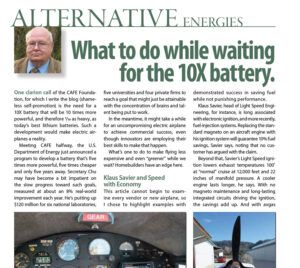
Such reexposure to electric power—which I enjoy very much—inevitably got me thinking about possibilities for the same in puddle-jumping aviation such as most of us practice. Now past its initial novelty stage, electric aviation propulsion has motored to that nascent period where wild enthusiasm must give way to more sober business and practicality concerns. Certainly mildly workable e-aircraft have been brought to market; Slovenian airframer Pipistrel already offers well-regarded electric trainers and motorgliders, along with electric power packages for those experimenters ambling the taxiways with two soldering guns slapping their hips.
Less visible to we enthusiasts at this point, over at the big airports commercial aviation is very much feeling the promise of electro-aviating. They’re up to their gear doors in proposals, prototypes and demonstrators for pure-electric, short-haul, commuter-type aircraft. Talk of up to 40-seat cattle cars is on the table. In fact, the commercial electric market is crowded with entrepreneurs, investment capitalists, stock specialists, some of the giant airframers and others who send out press releases full of terms such as “vertical mobility” or “decarbonize.”
Hit the Electron Pedal!
It’s safe to assume few of us have flown via electric power at this point, while some of us have no doubt taken a spin in an electric car. If you’ve yet to “hit the electron pedal,” don’t be surprised to find you like it when you do get the chance because electric power certainly offers advantages. It’s torquey so the power hits immediately, and in aircraft it is well matched to making oomph at propeller-happy rpm, so there is no need to enunciate aviation’s most nauseating acronym, “PSRU,” anymore. Similarly there is no need to warm up electric motors, and unlike the whirring innards of our storied piston engines, they have minimal moving parts. There is near-nothing to wear out, and maintenance is blessedly minimal to be essentially non-existent. That also means reliability is on near-parity with gravity, an especially fine thing in aviation. It also means trips to the oil dump will be quickly forgotten, and you’ll have to find another way to mix your blood and oil as decapitating oil filters into finger-slicing canisters will be just another granddad story.
Furthermore, if I was less experienced I’d cheerily report electric motor simplicity also means an idiot-proof pilot workload, but surely we’ll collectively find some way to screw up flipping a light switch. It’s just going to take more talent.
For aircraft designers electric power is, at least partially, a promising new playground. Where once we had to hang that big old lump of steel and aluminum, with it’s sprouting forest of cylinder cooling fins, via the magic of permanent magnets there is only the need to package a small stack of dinner plates because that’s about the size of a fly-to-breakfast electric motor. Pointy little noses on slender fuselages ought to become fashionable, and some of us might not have to make so many excuses as to why we want tandem seating in our next build.
But above all, electric power could be, like the little birdy says, “Cheap! Cheap! Cheap!” Well, cheap after acquiring an electric fly-buggy. Initial costs—especially if you need a whole new airframe to scoop all the benefits—could be full-on pickpocket stuff. But operating costs are lower than Red Bull racers under that bridge in Budapest, and maintenance should be about free. Condition inspections would consist of making sure the boxes and wires are still under the cowling, but what do you bet you’ll still have to change the D-cells in your ELT?
Not Ready for Prime Time
Naturally, there are real downsides, namely the inconvenience that electric power isn’t quite ready for prime time, and its overarching success is hardly assured. For starters, it’s heavier than sin, thanks to the U-boat bilge full of batteries required. The low energy density of today’s batteries is pitiful compared to a few gallons of 100LL on a joule-per-kilo basis to be fashionably metric about it. Yes, the holy grail of solid state electron storage beckons like a light in the night—or a mirage in the desert—but until such a storage breakthrough occurs, it’s tough seeing electric power going mainstream. For now, thoroughly enjoyable local sunset flights backed up by solar panel charging is electricity’s big contribution to sport flying.
There’s also the chicken-or-egg question regarding electric infrastructure. Without mainstreaming there won’t be any call for a thick, high-voltage cable hanging next to the gas pump (now there’s one for the lawyers), and without that big, fat cable at every airport, no one is flying cross-country on batteries unless someone standardizes batteries and has fresh ones stockpiled around the country. That’s fine for airliners plying their iron-tight schedules, but not quite on for the flitting about we do in our freedom machines.
And so I’m left with my impressions of intoxicatingly fast, gloriously quiet, expensive electric cars. They provide a wonderful driving experience and in some ways are much superior to the liquid fueled variety. Furthermore, in automotive there seems an inevitability to it, a sense of huge societal forces on the swell. Certainly the greens look no further than the missing tailpipe and declare, “See, no emissions!” and the politicians follow up with subsidies. Never mind the fossil-fueled electrical plant down the street.
But in aviation, the twin gorgons of excessive weight and missing government subsidies couple with the financial blood bath of initiating a whole new infrastructure. That makes me think I might be picking clinkers out of spark plugs for a while yet.


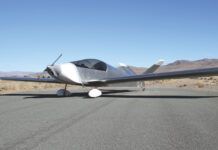
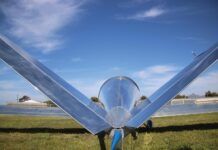

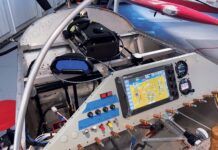

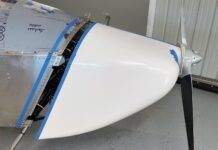

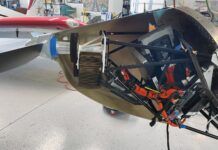
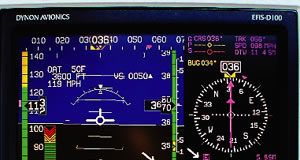

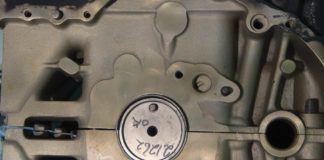

“Certainly the greens look no further than the missing tailpipe and declare, “See, no emissions!””
Hi Tom,
Thanks for the update on your thoughts about electric aircraft. Can’t disagree with your take — it’s not quite ready for a US market. Still, it would be cool to fly electric!
As to electric cars, I’m glad to hear that you enjoy them. I haven’t taken the plunge yet as my 2002 wagon still meets my needs. However, once the wagon dies, its replacement will be electric. Though I don’t own an electric car, I do know many people who do. None of them have the attitude or lack of knowledge about the realities of power generation that you tossed out there. Neither do the electric car proponents that I keep up with in various media. Maybe you should get out more often and meet more people. 😉
Best regards,
Jeff
Until batteries have the same, or better, power density than diesel-electric air vehicles will have a hard time being cost-effective for anything but trainers and short-haul traffic. But hybrids ought to have a wonderful future ahead, as the internal combustion engine is near its peak when we talk efficiency, and electric motors driving propellers is a well-established technology. The batteries needed to connect these two systems are quite small, and the electronics pretty basic.
The IC motor can be FADEC-equipped and constant-speed (minimizing wear and tear) while keeping the system under 500V is desirable from a health point of view. Twin props would be ideal, while the IC engine should sit in the nose of the aircraft, to ensure good cooling. The props could sit on the wing, or on a stub wing, like the Cri-Cri, making the cabling as short as possible.
Jay Leno’s hybridelectric Magneto car from 1910 (or thereabout), has no accelerator, it simply switches how the various windings in the motor-generator to either produce massive torque, or high speed. Sound just right for an aircraft!
I am not pro engine, nor am I anti electric powered aircraft. But until the electric motor gives me the range of gas, I am not a player. Sure the Tesla offers great styling, lots of technical dodads, but what you will never see is a Tesla on a cross country trip.
My wife and I recently did a cross country trip from Las Vegas to Cheyenne an back, and outside the city we do not see a single Tesla.
Now, if you can afford two cars, one for city driving, and one for cross country trips. As well as afford two airplanes, one for pattern work, and one for real flying, then electric is out of reach.
I appreciate the advantages of electric, but at this stage I cannot afford them. When the density of batteries matches the density of gas, I am all in.
Thanks for a great unbiased article Tom!
I am all for new technology and I love science since I was a little kid ( a very long time ago). I love aviation even more and love to see innovation there as much as possible. Sometimes, aviation can be settled in traditional ways and traditional airplane shapes, etc. but it also follows hard realities that must dance together with the innovation spirit. The Lord of Flight is so generous that some call flying greater than sex. At the same time, that Lord is totally unforgiving of our mistakes and out of control idealism, especially the one pushed hard by ideology and politics.
One does not need to get out more often and meet more people to see the hard reality of electric power limitations for the long haul and its lack of 100% “zero carbon” purity. Do not confuse mature prudence with childish stubbornness, unless you rest on that latter one. Electric flight will triumph if adjusted to that very slow speed of development and is not pushed hard ahead by ideological and political force. When you let your airplane go far ahead of you, you die. Same here with electric flight power. I just don’t want it to crash on the mountain of reality or for it to stall to death. I want it to triumph. Aviation deserves it.
Battery technology is advancing at breakneck speed; batteries with triple the watt hours per kilogram have just come out.
Comments above are out of step with what is coming down the pike.
Some vehicles are coming out with over 500 miles of range;; with older battery technology; vehicles with the newer battery technology giving 1100 miles are in the pipeline. (15 year battery warranty as well)
As this technology crosses over into aviation, electric aircraft with reasonable endurance are on the horizon.
Experimentals will pave the way, but don’t be surprised when mainstream manufacturers such as Diamond come out with viable cross country aircraft.
My 1960 airplane has about 315 nautical miles of range with reserve;
With the newer, lighter batteries now on the horizon, that will soon be achievable with an electric aircraft.
Please provide link(s) to the new 3x batteries.
Brian,
There’s so much hype nowadays in the battery R&D world. The proliferation of desktop publishing and profit incentives behind publications of “too good to be true”
performance leads nonspecialists to believe that great inroads will be made in few years. Read the US Department of Energy or EU’s technical evaluations of secondary battery emerging technologies to get a more evenhanded view. Price is dropping but large gains in specific energy require breakthroughs in conversion chemistries such as Li/S or more metal/air to make the leap to fully battery powered aviation.
If you’re going to mention electric car subsidies then it’s only fair to point out the 760 Billion dollars in annual subsidies provided to the US fossil fuel industry (2022 IMF estimate).
EV’s, whether auto or airplane are NOT emissions free. Electricity does not magically appear out of the air. It has to be generated, transmitted (via power wires), ad distributed.
There are a few (relatively speaking “green” energy plants i the US, but the vast majority of electricity generated by fossil fuel generated plants. These plants are more efficient than our ICEs, but the losses of transmission and distribution cancel out the increased efficiency. So, all you are doing is moving the CO2 emission sources from one place to another, at the cost of low energy density, short range, long recharge times, and massively increased empty weights.
I do like all the advantages of EVs, but don’t use zero-emissions as a reason. EVs aren’t!
(I’m not worried about CO2 nor Global Warming, but that’s another post for this curmudgeon).